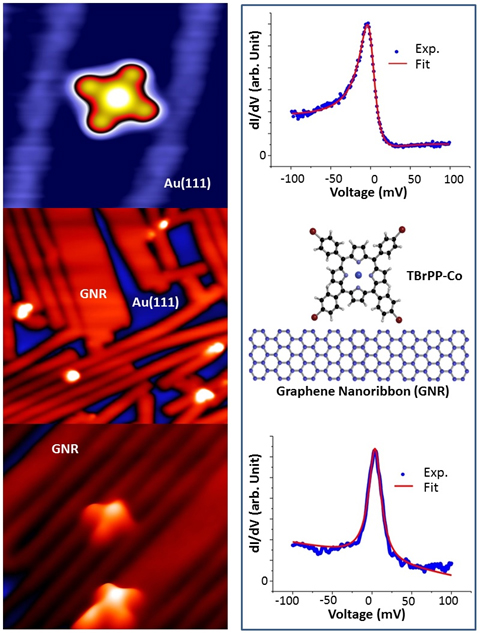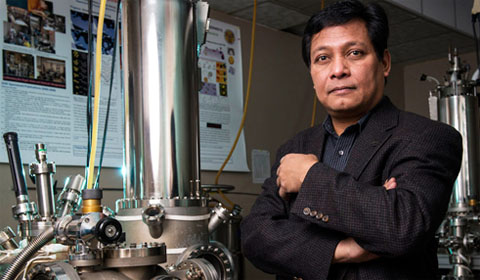
Dr. Saw-Wai Hla at a Scanning Tunneling Microscope (Photo: Robert Hardin)
Dr. Saw-Wai Hla and Dr. Sergio Ulloa, Professors of Physics & Astronomy at Ohio University, have published a journal article in Nature Communications about semiconducting graphene nanoribbons that could be better suited than graphene for applications ranging from electronic and optoelectronic devices.
The nanoribbons used for this research are strips of graphene from 1.5 to 4.2 nanometers (a nanometer is one billionth of a meter and the size of most atoms).
The article “Anomalous Kondo Resonance Mediated by Semiconducting Graphene Nanoribbons in a Molecular Heterostructure,” describes how Hla’s group experiments revealed an unexpectedly strong coupling between a magnetic molecule and a gold surface when an atomically precise semiconducting graphene nanoribbon is placed in between.
These nanoribbons—which could be synthesized using basic chemical ingredients—may give rise to novel applications in optoelectronic and spintronic devices in quantum information and storage.
Graphene is very popular in industry and research, but there is a drawback for applications in electronic industry because it lacks a bandgap. This means that graphene is a good conductor but it is less useful for the electronic devices. In contrast, the graphene nanoribbons, which are narrow strips of graphene, have bandgaps and they are semiconductors. Therefore, the graphene nanoribbons are very attractive for electronic device applications.
“In the current work, we use graphene nanoribbons to separate magnetic molecules from a gold crystal surface. In a way, we cover the gold surface with graphene nanoribbons (like carpets or floor mats) and then put magnetic molecules on top of the graphene nanoribbons,” Hla says. “Our goal is to prevent the interaction between the magnetic molecules and the gold surface underneath.”

Top image: Scanning tunneling microscope (STM) image of a TBrPP-Co molecule on gold and corresponding Kondo signal. A Kondo signal refers to the STM current observed. When the Kondo effect is present, the STM sees an increase of the current at very low voltages, which would otherwise not be there. The strength and width of the (conductance) peak is what is used to identify (signal) that the Kondo screening is there. Middle image: Graphene nanoribbon grown on a gold surface and models of TBrPP-Co molecule and graphene nanoribbons. Bottom image: TBrPP-Co molecules on graphene nanoribbons and corresponding Kondo signal. (Images courtesy: Saw Wai Hla)
The magnetic molecules illustrated here have a cobalt atom caged at the center (TBrPP-Co). The cobalt atom has a magnetic moment with a spin ½. On a gold crystal surface, the molecule interacts with gold both electronically and spintronically. This means that there is an electrical conduction between the molecule and gold when a voltage is applied as well as magnetic interactions.
“In order to separate the molecules from the gold surface, we get graphene nanoribbons on the gold by synthesizing them on surface from a precursor molecule called DBBA,” explains Hla. “We put the DBBA on the gold surface and then by heating them to 200 degrees Celsius lead to link these molecules and form long polymer chains. Further heating to 400 degrees Celsius produces graphene nanoribbons. These graphene nanoribbons have atomically precise edges. This synthesis procedure is already in use by other research groups around the world. We then deposit the magnetic molecules on these graphene nanoribbons.”
Hla’s team discovered that when they separate the molecules from the gold surface by placing graphene nanoribbons in between, they are electronically de-coupled as expected. This means that there is no electrical connection between the molecules and gold.
However, surprisingly, they discovered that the molecules are spintronically coupled to the gold surface, that is, there is a magnetic interaction. This spintronic coupling is very robust, almost as if directly on the gold.
“The magnetic molecules on graphene nanoribbons interact almost the same way as the ones directly located on top of gold surface without any graphene nanoribbons,” says Hla. “We detect the spintronic interaction between the molecules and the gold surface as a form of resonance known as ‘Kondo effect’. Kondo effect occurs when the electrons (in the gold here) dance around a magnetic impurity (the cobalt in the molecule) and essentially align their spins opposite the one of the magnetic impurity, so that by “collectively surrounding it” make its magnetic moment “disappear”, as distant electrons won’t see anything and won’t “feel the need” to align their spins. We say that the electrons in the gold have “screened out” the magnetic moment of the cobalt.”
“It turns out that the graphene nanoribbons mediate the magnetic interaction between the molecules and the gold surface underneath although they prevent electrical connection between them. This unexpected discovery can have a profound impact not only for the fundamental understanding of the materials properties but also for potential applications in spintronic devices and magnetic sensors.”
The experimental research was conducted by OHIO Physics & Astronomy graduate students Yang Li, Kyaw Zin Latt, and OHIO alum Heath Kersell (’08 B.S., ’11 M.S., ’16 Ph.D.), together with Hla with the support of Argonne scientists Brandon Fisher and OHIO alum Andrew DiLullo (’07 B.S., ’13 Ph.D.) The theory work was done by Ulloa together with Argonne National Laboratory scientists OHIO alum Anh T. Ngo (’11 Ph.D.) and Peter Zapol. This work as supported by the grants from the U.S. Department of Energy and National Science Foundation in addition to the partial supports from OHIO’s NQPI and CMSS.
Hla and Ulloa are members of OHIO’s Nanoscale and Quantum Phenomena Institute.
Abstract: Kondo resonances in heterostructures formed by magnetic molecules on a metal require free host electrons to interact with the molecular spin and create delicate many-body states. Unlike graphene, semiconducting graphene nanoribbons do not have free electrons due to their large bandgaps, and thus they should electronically decouple molecules from the metal substrate. Here, we observe unusually well-defined Kondo resonances in magnetic molecules separated from a gold surface by graphene nanoribbons in vertically stacked heterostructures. Surprisingly, the strengths of Kondo resonances for the molecules on graphene nanoribbons appear nearly identical to those directly adsorbed on the top, bridge and threefold hollow sites of Au(111). This unexpectedly strong spin-coupling effect is further confirmed by density functional calculations that reveal no spin–electron interactions at this molecule-gold substrate separation if the graphene nanoribbons are absent. Our findings suggest graphene nanoribbons mediate effective spin coupling, opening a way for potential applications in spintronics.



















Comments